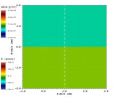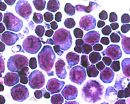(Press-News.org) Writing in Nature Physics, a large international team led by Dr Artem Mishchenko and Sir Andre Geim from The University of Manchester shows that the electronic properties of graphene change dramatically if graphene is placed on top of boron nitride, also known as 'white graphite'.
One of the major challenges for using graphene in electronics applications is the absence of a band gap, which basically means that graphene's electrical conductivity cannot be switched off completely. Whatever researchers tried to do with the material so far, it remained highly electrically conductive.
A new direction that has recently emerged in graphene research is to try to modify graphene's electronic properties by combining it with other similar materials in multilayered stacks. This creates an additional landscape for electrons moving through graphene and, therefore, its electronic properties can change strongly.
The University of Manchester scientists have used capacitance measurements to probe these changes. They found that in combination with a magnetic field this creates numerous replicas of the original graphene spectrum. This phenomenon is known as the Hofstadter butterfly but it is the first time that well developed replica spectra have been observed.
The researchers found a wealth of unexpected physics in this new system. For example, the Hofstadter butterflies turned out to be strongly contorted, very different from the theoretical predictions. This happens because electrons feel not only the landscape but also each other, which modifies the butterfly.
Another phenomenon that the Manchester paper reports is that graphene starts behaving at very low temperatures like a tiny ferromagnet. Usually, the higher the magnetic field, the more magnetic graphene become. The Hofstadter butterfly in Manchester's capacitors leads to an unexpected oscillating behaviour of the ferromagnetism. As new replica spectra emerge and disappear, so does the ferromagnetism.
Dr Mishchenko said: "It is really a new nice electronic system both similar to and different from graphene. We expect many more surprises. Let us first understand what it is and then we start talking about possible applications."
INFORMATION:
The Manchester paper is a collaboration that involved researchers from the University of Lancaster in the UK, National High-Field Laboratory in Grenoble in France, National Institute for Materials Science in Japan and a University of Belo Horizonte in Brazil.
Graphene's multi-colored butterflies
2014-06-01
ELSE PRESS RELEASES FROM THIS DATE:
Paired enzyme action in yeast reveals backup system for DNA repair
2014-06-01
The combined action of two enzymes, Srs2 and Exo1, prevents and repairs common genetic mutations in growing yeast cells, according to a new study led by scientists at NYU Langone Medical Center.
Because such mechanisms are generally conserved throughout evolution, at least in part, researchers say the findings suggest that a similar DNA repair kit may exist in humans and could serve as a target for controlling some cancers and treating a rare, enzyme-linked genetic disorder called Aicardi-Goutieres syndrome. The syndrome, an often fatal neurological condition, is found ...
Pitt team first to detect exciton in metal
2014-06-01
PITTSBURGH—University of Pittsburgh researchers have become the first to detect a fundamental particle of light-matter interaction in metals, the exciton. The team will publish its work online June 1 in Nature Physics.
Mankind has used reflection of light from a metal mirror on a daily basis for millennia, but the quantum mechanical magic behind this familiar phenomenon is only now being uncovered.
Physicists describe physical phenomena in terms of interactions between fields and particles, says lead author Hrvoje Petek, Pitt's Richard King Mellon Professor in the Department ...
Subtle change in DNA, protein levels determines blond or brunette tresses, study finds
2014-06-01
STANFORD, Calif. — A molecule critical to stem cell function plays a major role in determining human hair color, according to a study from the Stanford University School of Medicine.
The study describes for the first time the molecular basis for one of our most noticeable traits. It also outlines how tiny DNA changes can reverberate through our genome in ways that may affect evolution, migration and even human history.
"We've been trying to track down the genetic and molecular basis of naturally occurring traits — such as hair and skin pigmentation — in fish and humans ...
International collaboration replicates amplification of cosmic magnetic fields
2014-06-01
VIDEO:
This video simulation shows how a laser that illuminates a small carbon rod launches a complex flow, consisting of supersonic shocks and turbulent flow. When the grid is present, turbulence...
Click here for more information.
Astrophysicists have established that cosmic turbulence could have amplified magnetic fields to the strengths observed in interstellar space.
"Magnetic fields are ubiquitous in the universe," said Don Lamb, the Robert A. Millikan Distinguished ...
Researchers discover hormone that controls supply of iron in red blood cell production
2014-06-01
A UCLA research team has discovered a new hormone called erythroferrone, which regulates the iron supply needed for red blood-cell production.
Iron is an essential functional component of hemoglobin, the molecule that transports oxygen throughout the body. Using a mouse model, researchers found that erythroferrone is made by red blood-cell progenitors in the bone marrow in order to match iron supply with the demands of red blood-cell production. Erythroferrone is greatly increased when red blood-cell production is stimulated, such as after bleeding or in response to anemia.
The ...
Leptin also influences brain cells that control appetite, Yale researchers find
2014-06-01
Twenty years after the hormone leptin was found to regulate metabolism, appetite, and weight through brain cells called neurons, Yale School of Medicine researchers have found that the hormone also acts on other types of cells to control appetite.
Published in the June 1 issue of Nature Neuroscience, the findings could lead to development of treatments for metabolic disorders such as obesity and diabetes.
"Up until now, the scientific community thought that leptin acts exclusively in neurons to modulate behavior and body weight," said senior author Tamas Horvath, the ...
Mayo Clinic: Ovarian cancer subtypes may predict response to bevacizumab
2014-06-01
CHICAGO — Molecular sequencing could identify ovarian cancer patients who are most likely to benefit from treatment with bevacizumab (Avastin), a Mayo Clinic-led study has found. Results of the research were presented today at the 2014 American Society of Clinical Oncology Annual Meeting.
The addition of bevacizumab to standard therapy extended progression-free survival more for ovarian cancer patients with molecular subtypes labeled as "proliferative" or "mesenchymal" compared to those with subtypes labeled as "immunoreactive" or "differentiated," says Sean Dowdy, M.D., ...
Oncologists: How to talk with your pathologist about cancer molecular testing
2014-06-01
As targeted therapies become more available, increasing opportunity exists to match treatments to the genetics of a specific cancer. But in order to make this match, oncologists have to know these genetics. This requires molecular testing of patient samples. An education session presented today at the American Society for Clinical Oncology (ASCO) Annual Meeting 2014 details the challenges in this process and makes recommendations that oncologists can use to ensure their patients' samples are properly tested, helping to pair patients with the best possible treatments.
"The ...
Chemotherapy following radiation treatment improves progression-free survival
2014-06-01
CHICAGO — A chemotherapy regimen consisting of procarbazine, CCNU, and vincristine (PCV) administered following radiation therapy improved progression-free survival and overall survival in adults with low-grade gliomas, a form of brain cancer, when compared to radiation therapy alone. The findings were part of the results of a Phase III clinical trial presented today at the 2014 American Society of Clinical Oncology Annual Meeting by the study's primary author Jan Buckner, M.D., deputy director, Cancer Practice, at Mayo Clinic Cancer Center.
"On average, patients who ...
New report estimates nearly 19 million cancer survivors in the US by 2024
2014-06-01
ATLANTA – June 1, 2014 – The number of cancer survivors in the United States, currently estimated to be 14.5 million, will grow to almost 19 million by 2024, according to an updated report by the American Cancer Society. The second edition of Cancer Treatment & Survivorship Facts & Figures, 2014-2015 and an accompanying journal article published in CA: A Cancer Journal for Clinicians find that even though cancer incidence rates have been decreasing for ten years, the number of cancer survivors is growing. This is the result of increases in cancer diagnoses driven by the ...

